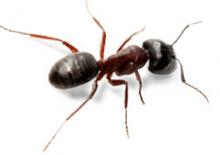Ants in your window sill?
Ants are the most frequent and persistent pests encountered around homes and buildings. Once considered being a summer pest, ants have now made their way into our homes and are now making appearances in the fall and occasionally in the winter months as well. Besides being a nuisance, ants will contaminate food and literally take over your kitchen counter tops and invade your window sills.
 The odorous house ant has become the most common and difficult ant species to control in Virginia. The ant is small (1/8-inch), darkish, and forms distinct trails along outdoor and indoor surfaces.
The odorous house ant has become the most common and difficult ant species to control in Virginia. The ant is small (1/8-inch), darkish, and forms distinct trails along outdoor and indoor surfaces.
It is often mistaken for the pavement ant, which can readily be controlled with most baits. The most accurate diagnostic difference, visible under magnification, is the absence of a noticeable node or “bump” along the constricted area between thorax and abdomen of the odorous house ant. Pavement ants have two obvious nodes, and fine grooves or striations along the head and thorax. Pavement ants also are more likely to displace bits of soil from their typical nesting location under sidewalks, driveways and other paved areas. Odorous house ants emit what’s been described as a rotten coconut or pine scent when crushed with a finger and sniffed.
 Odorous house ants will nest in virtually every imaginable location. They commonly nest outdoors under pavement, stones, mulch, woodpiles, flower pots, and house siding, foraging indoors for food and moisture. Nests also occur indoors within wall cavities, appliances, potted plants, etc., especially near sources of moisture. The nests tend to be mobile; colonies relocate fast and often in response to changes in weather and disturbance.
Odorous house ants will nest in virtually every imaginable location. They commonly nest outdoors under pavement, stones, mulch, woodpiles, flower pots, and house siding, foraging indoors for food and moisture. Nests also occur indoors within wall cavities, appliances, potted plants, etc., especially near sources of moisture. The nests tend to be mobile; colonies relocate fast and often in response to changes in weather and disturbance.
Odorous house ant colonies tend to have numerous, egg-laying queens and the primary colonies may split into smaller ones for no apparent reason. Ants foraging indoors feed on all manner of foods, ranging from the trash can to the cereal bowl.
This particular ant is difficult to control, especially by householders. The better baits to try are often syrupy ones, such as Combat® Ant Killing Gel or Terro® Ant Killer II. As with all ants, activity indoors can sometimes be reduced by removing ready access to food and moisture (water leaks, spillage, trash cans, pet food dishes, etc). Temporary relief can sometimes be had by wiping away the invisible odor trails with a kitchen cleanser or mild detergent. Do not disturb foraging trails, however, if you are using a bait. Caulking obvious ant entry points also may be helpful, along with trimming back shrubs and limbs touching the building. In nature, this ant feeds extensively on plant nectar and honeydew excreted by plant-sucking insects such as aphids.
When odorous house ants are the problem, homeowners may be better off calling a professional.
If you encounter an ant infestation in your home consider contacting a local exterminator to seek out and eliminate the ant colonies thus reducing the ant activity. An ant control program offered by your local pest control company insures that the ant infestation will be eliminated and that the ants that you are seeing on your window sills and counter tops will quickly disappear.
Learn more about ODOROUS HOUSE ANTS
Learn more about ANT CONTROL
Tags: ant control, ant exterminator


































































